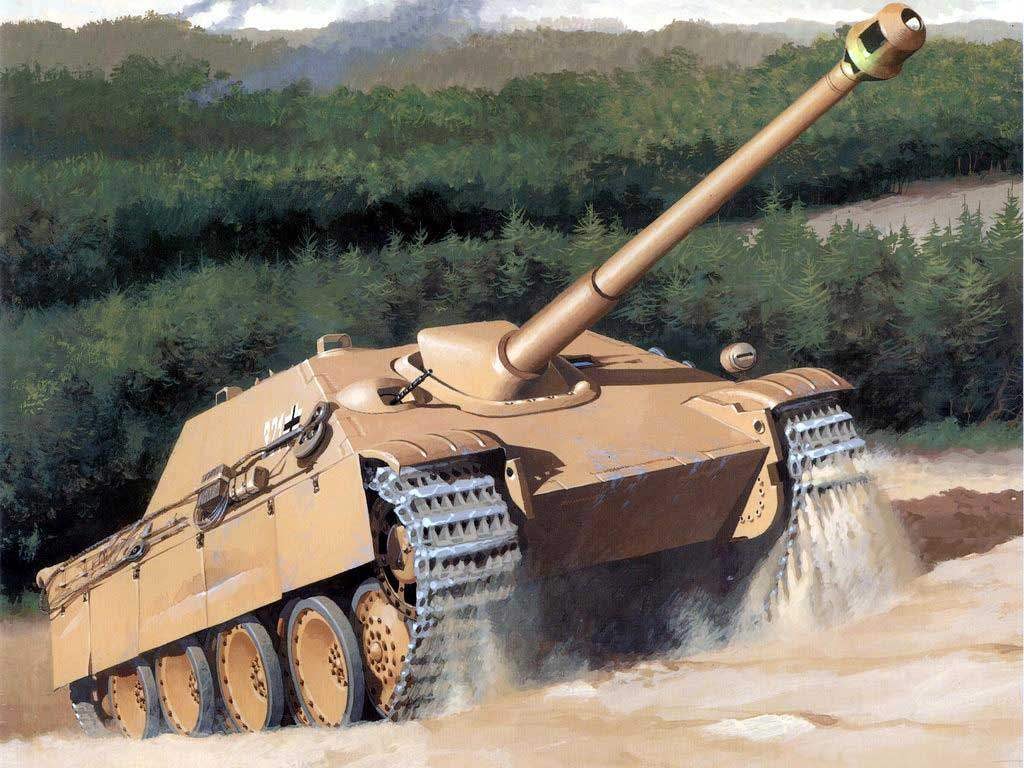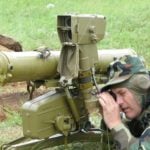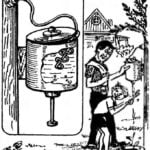
 Shortly after the outbreak of the Second world war, the Germans faced a serious crisis in the anti-tank artillery. Their primary 37-mm gun Cancer 35/36 was completely powerless against the well armoured French tanks. Adopted after it adopted a 50-mm Cancer 38 also has not solved the problem. In France, she did not, as the first 17 guns to the Wehrmacht was only in July 1940, and the test of battle she had already take place on the Eastern front. The result was disastrous to penetrate the armor of T-34 and KV she could only close range. More or less this task was done only for 75-mm gun Pak 40 that began to enter the army in February 1942 and became the most massive German anti-tank gun of the Second world war.
Shortly after the outbreak of the Second world war, the Germans faced a serious crisis in the anti-tank artillery. Their primary 37-mm gun Cancer 35/36 was completely powerless against the well armoured French tanks. Adopted after it adopted a 50-mm Cancer 38 also has not solved the problem. In France, she did not, as the first 17 guns to the Wehrmacht was only in July 1940, and the test of battle she had already take place on the Eastern front. The result was disastrous to penetrate the armor of T-34 and KV she could only close range. More or less this task was done only for 75-mm gun Pak 40 that began to enter the army in February 1942 and became the most massive German anti-tank gun of the Second world war.
Nevertheless, various German firms continued work on the creation of ever more powerful artillery systems capable to release the 88-mm anti-aircraft gun from the solution of unusual problems for her fight tanks. With this purpose, the firm Krupp developed a Great gun 42, which was adopted for service as a
8,8 cm Pak 43 (88-mm anti-tank gun model 1943). The gun had a barrel length of 6280 mm and weight 3650 kg. the Use of a cruciform carriage with sliding frame reduces the height of the gun in firing position to 1720 mm at the upper edge of the shield. Due to difficulties with the production of these first six carriages of the guns managed to convey to the army in November 1943. In order to accelerate the delivery of much-needed army guns, Krupp developed a version of the 8,8 cm Pak 43/41, which was used for the carriage of a light field howitzer and the conventional wheel speed from the heavy field howitzers. The first 70 of these guns came to the front in April 1943.
In conjunction with the design of towed artillery systems 88-mm caliber was the process of creating a self-propelled variants. So, in February 1943, the firm Deutschen Eisenwerken began production of the tank destroyer Hornisse (“Hornet”) on the basis of the so-called single chassis GW III/IV. However, a disadvantage of this self-propelled gun was an easy booking (open the rear and top combat tower defended the 10-mm armor plates) and high silhouette — 2940 mm.
The need for a powerful, well-armoured tank destroyer was obvious. Therefore, 6 January 1942 in the course of works on creation of the Pak 43 gun, the Krupp firm gave an order for the design of self-propelled installation armed with this tool, the Project received the designation Panzer Selbstfahrlaffette IVc-2. Tactical and technical requirements provided combat weight of about 30 tons; good armour protection: skull — 80 mm, side 60 mm; max speed 40 km/h. Assumed the use of the engine Maybach HL 90. By June 17, 1942, the Krupp plant in Magdeburg have produced three prototype self-propelled guns on tank chassis Pz.IV.
However, on August 3, 1942, the armaments Department has decided to use to host the 88-mm gun Pak 43 (which did then only the first shots) of the chassis of the tank “Panther”, is also still under development. Initially, the project was entrusted to the firm of Krupp, which experts have determined that the chassis of the Panther to embed such a powerful weapon requires revision. In the opinion of the engineers of the company, the preliminary design could be completed by January 1943. In September, they have produced a model in scale 1:10. On 15 October 1942 at a meeting in Reyhsministerstvom the war economy and industry, held under the direction of Speer, it was decided to transfer the further development of the Daimler-Benz, as initially build a new SAU was planned at the enterprises of this firm. However, Krupp had continued to carry out the design work. 16 November kruppova produced a full-scale wooden model, which bore little resemblance to the final version of the ACS.
January 5, 1943 at the meeting of the technical Committee of firm Daimler-Benz has identified a number of technical requirements for the future model (then called 8.8 cm Sturmgeschütz — 88-mm assault gun). Thus, the thickness of the upper frontal bronelista was to be 100 mm, bottom 60 mm, the angle of inclination is 60°. The thickness of the sheets of the roof, sides and stern — 30 mm with the same slope. The breach of the gun was supposed to be made of high quality armor and fastened to the housing by bolts, which should ensure quick dismantling for the guns. Components of the transmission and gearbox could be replaced to be removed through the recess. The crew was to consist of six — commander, gunner, driver, radio operator and two loaders.


Self-propelled artillery installation “Jagdpanther”:
1 — 88-mm gun; 2 gun mask; 3 — container swab; 4 — Trak spare; 5 — commander’s observation instrument; 6 — monitoring devices; 7 — hatch commander’s; 8 — cap vents; 9 turning the surveillance device 10 to air receiver window of the cooling system of the engine; 11 – the hatch of the engine compartment; 12 — right window vent valves of the cooling system of the engine; 13— air vents for air flow to the air filters 14 — of the tank’s filler cap fuel tanks, 15 — armor hood air Windows; 16 — hatch for filling water in the cooling system; 17 — left window vent valves of the cooling system of the engine; 18 – guard-stops the lid opening hatchway; 19 — Luke loader, 20 — a fan cover; 21 —recess device of the melee; 22 — Luke periscopic sight; 23 – headlight with svetamaksimova nozzle; 24 — set exchange machine gun; 25 — a surveillance device of the driver; a 26 — drawer for equipment; 27 — the aft hatch; 28 plug auxiliary antenna input; 29 — antenna input; 30 the hatch for loading ammunition; 31 — Jack; 32 — the flame arrestor on the exhaust pipe; 33 — tow earring; 34 the hatch to the drive inertia of the Jack. 35 — the hatch to the engine drive from the crank; 36 hatch for access to engine compartment; 37 —the hatch to the boiler water cooling system; 38 — the hatch to the mechanism of a tension of caterpillars; 39 guard lantern. On the front spare tracks are conventionally not shown
The original design was intended to produce a new self-propelled gun on the basis of the “Panther II”, but on 4 may 1943 the Ministry of armaments has decided to temporarily freeze this project, and the developers were forced to make changes to an existing design with the aim of unifying nodes of the future ACS with the tank “Panther”.
Serial production due to busy factories Daimler-Benz has instructed the firm MIAG (Muhlenbau-AG industry). In September 1943 there were collected the first cabin. In accordance with the technical specifications, the thickness of the frontal armor was 80 mm, the sides of the wheelhouse and the lower frontal hull and 50 mm, sides and stern of the hull is 40 mm, the roof of the deckhouse — But 30 mm in this embodiment, the cutting was too heavy, so the roof thickness had to be reduced to 25 mm. has Changed the design of the carriage instead of the planned sector of attack of 14° left and right it provided only 12°. The crew was reduced to five people. October 20, 1943, a wooden mock-up was demonstrated to Hitler on the ground of ARIS in East Prussia, and on December 17 the first prototype left the factory floor.
Serial production began at the factory of the company MIAG in Braunschweig in February 1944. At the end of the month according to the orders of the führer, the car has received the name Jagdpanther II”Jagdpanther” (literally, the hunting Panther, peterokatnici) and the index of the Sd Kfz.173 according to the system of notation of the combat and transport vehicles of the Wehrmacht. The production plan provides for a monthly edition of 150 “jagdpanther”. Before the war the firm MIAG and joined her in December 1944 MNH (Maschinenfabrik Niedersachsen Hannover) was able to produce 384 of the machine. Its peak production was reached in January 1945 when the factory shops left 72 combat vehicle.
Some sources report 413 or 417 self-propelled guns and about 425 even, released until may 1945. But the fact that the German statistics of production of military machines ends mid-March 1945, and the number of “jagdpanther”, made later, nothing definite can not be argued, moreover, that both plants were subjected to severe attacks by U.S. aircraft.
“Jagdpanther” was a self-propelled artillery installation with a front stationary armored cabin. The case of the ACS were characterized by a large inclination of the armor plates as frontal (55° to the vertical) and side (30° to the vertical). Even the top of the cabin had a small angle of inclination. Sharedetails the upper front plate was slightly decreased only in the slit viewing device of the driver and recess bow machinegun. All the hatches for the embarkation and disembarkation of crew members were on the coach roof. The design feature of the ACS was that the cabin was a single unit with the case, instead of fastened thereto with bolts or by welding, as most German self-propelled guns.

Mask gun and trim loopholes
In the hull of the massive cast of the mask of type Saukopf gun mounted the 8.8 cm PaK43/3L/71 (or РаК43/4 L/71) caliber 88 mm. Length of the gun barrel with muzzle brake dvuhkosournymi was 6686 mm, weight 2200 kg. the angle of the horizontal aiming gun ±11°, elevation +14°, declination -8°. In gun ammunition consisted of 57 unitary shots with armor-piercing, armor-piercing, high-explosive and heat shells. The initial velocity armor-piercing projectile There is. 39/43 weight of 10.16 kg (weight of the shot — 23.4 kg) was 1000 m/s At a distance of 1000 meters, he fired 165-mm armor. Armor-piercing projectile There is. 40/43 tungsten core had an initial speed of 1130 m/s and at the same distance punched 193-mm armor. The maximum range of the shot — 9350 m, the height of the line of fire of 1960 mm, rate of fire 6-8 rounds per minute.
The gun is supplied with a vertical wedge breech and semi-automatic opernogo type. Recoil device mounted over the gun barrel and consisted of a hydraulic brake rollback (right) and air-liquid nachalnika (left). The lifting mechanism of the gun is screw-type. A gunner had a periscope sight Sfl ZF1a.
Auxiliary armament “Jagdpanther” consisted of a MG 34 machine gun was placed to the right of the gun in a ball mount. The machine gun ammunition — 1200 rounds. At the disposal of the crew, there were two pistol-machine gun MP-40 with ammo 384 rounds.
The “Jagdpanther” was established 12-cylinder V-shaped gasoline four-stroke engine Maybach HL-230P30 700 HP at 3000 Rev/min Transmission consisted of a driveline, the three-disk main friction clutch, the gearbox AK 7-200, the rotation mechanism of the company MAN, final drives and disc brakes. Transmission — three-shaft, with longitudinal shafts, a seven-speed, patentowa, constant-mesh gears and simple cone synchronizers to enable transmission from 2 nd to 7 th. Actuators combined with gidrotruboprovod tracking actions with mechanical feedback.
Chassis SAU applied to one side consisted of eight dual road wheels with rubber tires with a diameter of 850 mm. Suspension — personal torsion. The front and rear rollers supplied with hydraulic shock absorbers. Drive wheels located in front and rails in the back. Caterpillar steel melkopilchatye, 86 odnoklubnik tracks each. Engagement — cycloid.
Engine, transmission and suspension allowed the car with a mass of 45.5 MT to reach a maximum road speed of 46 km/h on rough terrain — 24 km/h; cruising range, respectively, 200 and 100 km of fuel tank capacity 700 liters
In the production process, the design changes were made, however minor. In particular, changing the trim of the gun embrasures, the number of periscopes and, accordingly, the observation of cracks at the driver. Binocular gun sight was replaced by a monocular. Since the summer of 1944 the gun instead of the barrel-monoblock received a composite barrel, which facilitated its dismantling. Then on the roof of the wheelhouse placed three nests for fastening of 2-t crane. In the casemate roof mounted “device melee” (Nahverteidigungswaffe) — 90 mm NbK 39 mortise to fire frag and smoke grenades (in their ammunition consisted of 16 pieces). In September 1944, the machine has ceased to cover timeritem. In October 1944 on the “Jagdpanther” a new gun mask, fastened to the frontal armor of eight bolts. Exhaust pipes equipped with flame arresters sheet (Flammvernichter). SAU later editions had an additional fan placed in the front of the roof of the fighting compartment.
In addition to the linear-propelled guns were manufactured a few cars in the commander’s option. They were equipped with additional radio Fu Fu 7 and 8, and also had a night vision device.
“Jagdpanther” formed a special heavy fighter-RGK anti-tank battalions (schwere Panzer Jager Abteilung), were, as a rule, subordinate to the command field and tank armies. The staff battalion “jagdpanther” was to consist of 30 combat vehicles, which in practice is never observed. Fortunately for us and for our allies, the Germans managed to produce too little of these self-propelled guns.
The first eight cars got 2nd company 654-th heavy anti-tank battalion RGK. Their baptism of fire took place on 30 June 1944, in France. Near Le Lying in Normandy, a squadron of the 6th English tank brigade ran into three “jagdpanther” 654 th division. The fight was extremely short. In two minutes, “jagdpanther” destroyed 11 “Churchill”!
Soon new combat vehicles rearmed 519, 559, 560 and 655-th heavy anti-tank battalions of the RGC, each of which had in its composition one company, equipped with “jagdpanther-Rami”. It should be noted that in 1944 on the Eastern front “jagdpanther” was not used but already in February 1945 in the fighting was attended by five divisions, each of which had in its composition the company, consisting of a 14 “jagdpanther”. In the counter-offensive of the German troops in the Ardennes participated, at least 56 “jagdpanther” consisting of six battalions of tank destroyers, and about 12 in various parts of the SS. Regarding the latter, most “jagdpanther” received 2nd SS Panzer division “das Reich”, 9th SS Panzer division “Hohenstaufen” and the 10th SS Panzer division “Fronds-Berg”. The latter fought 42 “jagdpanther”. They took part in the offensive, the 6th SS Panzer army in the area of lake Balaton in Hungary and in the battle for Budapest in January 1945. In early April, in the fighting on the outskirts of Vienna took part and was hit past 12 “jagdpanther” of this division.

On 1 March 1945 the front had 202 “jagdpanther”, but within a month, in terms of actual dismissal, and their number rapidly declined. Of the 56 machines of this type 40 was technically faulty, and the remaining 10 to April 11 were in 616-m anti-tank division (Pz.Jg.Abt.616) on the Eastern front and five in the Pz.Jg.Abt.512 on the West. By 28 April on the Eastern front there are 19 cars (11 of them combat ready), in the West — 27 (five operational).
After the war, “jagdpanther” some time was in service in the French army units stationed in Satori and Bourget.
“Jagdpanther” — the most powerful German tank destroyer of the Second world war (despite several drawbacks of the power plant and running gear of the tank “Panther”). Having the same armament as the “Ferdinand”, it was more compact and maneuverable. Nothing like the Western allies to end the war has created. Our SU-85 was less armored and yielded to the power of the weapons (initial velocity armor-piercing projectile gun D-5C was 792 m/s). And only SU-100, serial production of which began in September of 1944 (before the end of the war there were about 1,400 vehicles), having a lower combat weight exceeded “Jagdpanther” as to the power of weapons and armor protection.
Currently, “jagdpanther” preserved in the Museum of the Aberdeen proving ground in the United States, in the Swiss tank Museum in Thun, in the tank Museum in Munster (Germany) and Samurai (France), the Imperial war Museum (Imperial War Museum) in London and in the Museum of armored vehicles in Kubinka near Moscow.
THE PERFORMANCE CHARACTERISTICS OF THE ACS “JAGDPANTHER”
Combat weight, t………………………………………………………………….45,5
Crew………………………………………………………………………..5
Overall dimensions, mm:
dline…………………………………………………………………………………9870
width………………………………………………………………………………3270
wysota……………………………………………………………………………….2715
clearance……………………………………………………………………………..560
The height of the line of fire, mm……………………………………………………….1960
Max. speed, km/h:
on the highway……………………………………………………………………………46
on the terrain …………………………………………………………………….24
Cruising range, km:
on the highway…………………………………………………………………………..200
on the terrain…………………………………………………………………….100
Overcoming obstacles:
the angle of elevation, deg……………………………………………………………30
the width of the ditch, m…………………………………………………………………..2,45
wall height, m……………………………………………………………….0,9
fording depth, m………………………………………………………………1,55
Specific pressure, kg/cm2 0,9 Specific power, HP/t….15,63
M. BARYATINSKY



